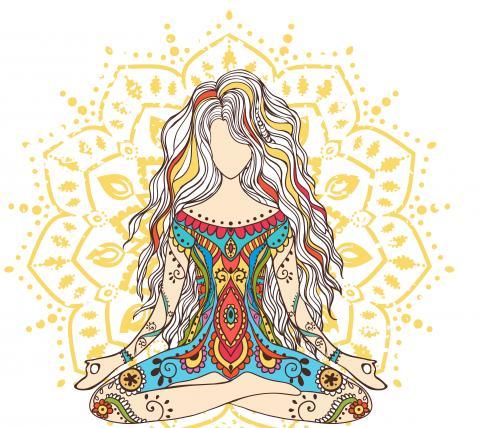
Maybe you’ve heard yoga is great for your body, mind, and spirit, but you can’t get into it. Maybe you’ve been doing yoga for years, but you don’t feel as connected to your practice as you used to.
Some of us commit to a particular yoga style and never look back, but if you’re still looking for that perfect asana practice, or you want to mix things up in your current practice, you might find the remedy through the discovery of your dosha.
According to Ayurveda, India’s ancient whole-body system of medicine, the five universal elements (earth, water, fire, air, and space) configure themselves in individuals in three energy types, or doshas: vata, pitta, and kapha.
To better understand how our yoga practices affect the doshas (and vice versa), I talked to Jenna Furnari, M.A. in Ayurveda, Certified Ayurvedic Practitioner, E-RYT 500, and Co-Founder of Satyam Yoga Teacher Training in Monterey, California. “The goals of Ayurveda are to sustain health and to treat imbalance not by treating the symptoms, but by removing the cause,” she says. Lifestyle changes, diet modifications, spiritual practices, and herbs make up Ayurveda’s toolbox. Practitioners make recommendations based on the client’s proportion of doshas, or energy and physiological principles.
All three doshas are present in each of us, but one or two tend to be dominant. “Just like everyone has a unique thumbprint, the doshas make up what you can consider your ‘energy print,’” says Furnari. We can use awareness of our individual energy prints to view our bodies, constitutions, and tendencies from a new perspective, “enabling us to make skilled decisions in the way we function and live.” When we’re in balance, the doshas “preserve our health and vitality,” says Furnari. “When imbalanced, they lead to illness or disease.”
According to Furnari, understanding your dosha makeup is the first step toward finding a practice style or approach that cultivates balance. Use these brief summaries to gauge the proportions of these energies in your own body:
Vata energy is made up of air and space, and fosters variety and change. Vata types, or those with a dominant vata dosha, often have a particularly tall or short body frame and cool body temperature. Energetic and creative, they tend towards nervousness, anxiety, and insomnia when imbalanced.
Pitta, the combination of fire and water, is the energy of focus and determination, and pitta types commonly have a medium or athletic build and warm body temperature. They’re quick learners with a fiery energy that, when out of balance, can manifest as anger or frustration.
Kapha, made up of water and earth elements, is a calm and methodical energy, and kapha types may have a broad, evenly proportioned body frame, a steady personality, and a good memory. Too much kapha energy can lead to greed, stubbornness, and lethargy.
To further explore how the doshas play out in your physical makeup, mental qualities, and biomedical functioning, check out this quiz on Basmati.
One of the key principles of Ayurveda, Furnari notes, is that “like increases like, and opposites balance.” So if you’re a pitta type, a yoga practice that creates heat and “fire” in the body will increase, and possibly aggravate, your already-dominant pitta qualities. We tend to crave things that perpetuate our imbalances, and knowing our “energy print” can help us choose asana practices that oppose, and balance, our prevailing energies.
Once you’ve determined your dominant dosha or doshas, take a look at the practice suggestions below:
Vata
You probably gravitate toward: Mystical or esoteric practices, and styles involving creative, intuitive flow and dance elements
For a more grounding practice, try: Classes labeled gentle flow/vinyasa, or Yin
To make any practice more grounding for vata:
- Keep your eyes open
- Focus on grounding through all four corners of the foot
- Hold poses for at least 3-5 breaths
- Stick to a routine
- Make use of props
- Move through connections mindfully
- Focus on symmetrically aligned poses in which hips are square, such as Warrior I
Pitta
You probably gravitate toward: Heating practices such as Ashtanga, hot yoga, and Power Yoga
For a more cooling practice, try: Restorative yoga, Yin yoga
To make any practice more cooling for pitta:
- Practice with your eyes closed
- Avoid “muscling into” or straining in poses
- Slow the breath, and focus on your exhalation
- Synchronize movement with breath
- Skip chaturangas or connective vinyasas
- Avoid mid-day practice (11am-2pm is a pitta time of day)
- Focus on asymmetrical poses that open through the hips, such as Warrior II
Kapha
You probably gravitate toward: Yin yoga, slower-paced classes, or no yoga at all
For a more heating practice, try: Vinyasa styles, or practices with rigid structure such as Iyengar.
To make any practice more energizing for kapha:
- Practice heating breaths such as ujjayi
- Move at a quicker pace
- Practice regularly, but mix things up (different styles, times, teachers, etc.)
- Focus on backbends
- Make small changes gradually, working up to two to three asana practices a week
Regardless of the style you choose, keep in mind that finding the practices best suited to you is a continuing process. “Practice takes practice,” Furnari says. Our bodies naturally change throughout the day, with each season, and over time. Our practices should change accordingly. Stay curious, listen to your body, and reassess often.
If you’re taking a class with a new teacher, and especially if you’re new to yoga, Furnari suggests arriving early to talk to the teacher about what you’re hoping to receive from the class. If you can, meet with an Ayurvedic specialist, who can help you develop a practice and lifestyle plan tailored to your unique dosha makeup. Furnari can be reached for in-person or online consultations through www.jennafurnari.com and www.thewholebodysolution.com.








